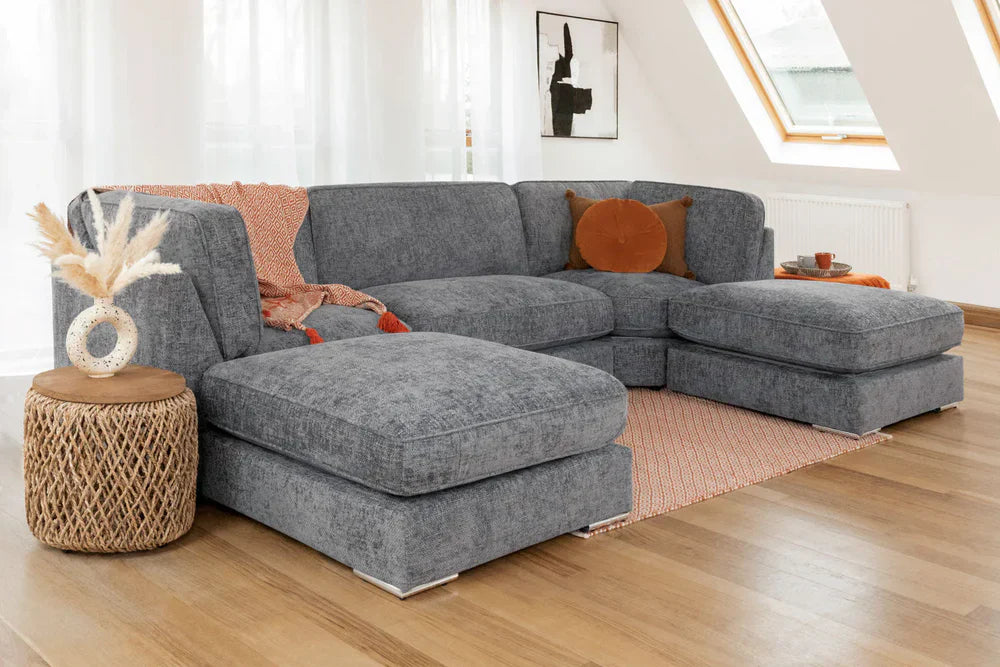Buying a new sofa is one of the biggest furniture investments most households make. It’s where you relax, entertain, nap, snack, and spend countless hours with family. So it’s no surprise that one of the most common questions people ask is: how long should a good sofa last?
In this blog, we’ll break down the average lifespan of a sofa, the factors that influence how long it stays comfortable and supportive, and how you can get the best value from your next purchase.
How Long Does a Sofa Typically Last?
There’s no one-size-fits-all answer, but on average, a quality sofa will last between 7 and 15 years. This depends heavily on how it’s made, how it’s used, and how well it’s cared for over time.
Most budget sofas are expected to last closer to the lower end of the range, while mid-range and high-end models with solid construction and quality materials can exceed a decade of regular use.
- Sofas in high-use areas may show signs of wear after 5–7 years
- A well-built, well-maintained sofa can remain structurally sound for 10–15 years
- Comfort tends to decline before structure—cushions lose shape and springs wear
- Lifestyle factors like pets, children, and daily use significantly reduce longevity
The Materials That Matter Most
The materials used in your sofa—inside and out—play a major role in determining how long it will last. A low-cost frame or cheap upholstery can dramatically shorten the sofa’s useful life, while quality components help it hold up for the long haul.
- Frames: Hardwood frames (like beech or oak) are stronger and longer-lasting than softwood or particleboard
- Springs: Sinuous (zig-zag) or eight-way hand-tied springs offer better support and durability than webbing
- Cushions: High-density foam retains its shape longer than lower-grade or hollow fibre fillings
- Upholstery: Durable fabrics like faux leather, chenille, or tightly woven polyester blends resist wear better than delicate materials
Usage: The Daily Impact on Your Sofa’s Lifespan
Even the highest-quality sofa will age faster if it’s constantly in use. A sofa in a formal sitting room will last longer than one used daily by an entire household—including kids and pets.
Consider how your sofa is used before estimating its expected lifespan:
- Everyday use leads to faster fabric wear, sagging cushions, and structural stress
- Households with pets see quicker fabric deterioration due to claws and fur
- Children tend to add wear through jumping, spills, and general rough play
- Occasional-use sofas in guest rooms or secondary living spaces tend to last significantly longer
Signs Your Sofa Is Reaching the End of Its Life
Even if a sofa still looks okay, it might not be offering the support or comfort it once did. Knowing the signs of a worn-out sofa helps you decide when it’s time to replace rather than repair.
Watch for these common indicators:
- Sagging seats or cushions that no longer bounce back
- Creaking noises from the frame or springs when you sit down
- Visible damage to upholstery that’s difficult to clean or patch
- Loss of support in the back or arms, making sitting uncomfortable
Extending the Life of Your Sofa: Practical Tips
Want your sofa to last longer? A little maintenance goes a long way. With regular care, even an affordable model can remain in good condition well beyond the average.
- Rotate cushions regularly to prevent uneven wear and sinking
- Vacuum fabric weekly to remove dust, crumbs, and pet hair
- Use armrest covers or throws to protect high-contact areas
- Treat stains promptly to avoid permanent damage and discolouration
When Repairs Are Worth It (and When They're Not)
Not every worn-out sofa needs to be replaced immediately. In some cases, minor repairs or upgrades can restore comfort and extend its life. In others, the cost of fixing it may exceed its value.
Here’s when it makes sense to repair:
- The frame is solid, and only the cushions or covers need attention
- Minor upholstery tears can be patched or stitched
- New foam inserts can revive flattened seat cushions
- The sofa fits your space perfectly and matches your décor
But it may be time to replace if:
- The frame is cracked, broken, or wobbly
- Upholstery is heavily stained, ripped, or worn through
- You’ve already repaired it multiple times with minimal improvement
- It’s no longer comfortable or supportive
Fabric vs Faux Leather vs Real Leather: Which Lasts Longest?
The type of upholstery you choose has a big impact on durability. While style matters, material performance should play a central role in your decision—especially if you’re expecting years of regular use.
- Faux leather: Easy to clean and budget-friendly but may crack or peel after 4–6 years with heavy use
- Woven fabrics: Vary widely—chenille and polyester blends often last 7–10 years with proper care
- Real leather: Durable and ages beautifully with proper maintenance, often lasting 15+ years
- Velvet and delicate fabrics: Look great but tend to wear more quickly in busy households
Does Price Reflect Sofa Lifespan?
To an extent—yes. Cheaper sofas are usually made with lower-cost materials, which can mean a shorter lifespan. But that doesn’t mean you need to spend thousands to get a long-lasting piece.
The key is knowing what to look for in your price range:
- In the budget range (£300–£600), expect 4–7 years with moderate use
- In the mid-range (£600–£1,200), expect 8–12 years with good care
- In the premium range (£1,200+), frames and cushions may last 15 years or more
That said, many affordable sofas today—like those from Ready2Go Furniture—are built with solid frames and hardwearing fabrics, offering excellent value for money.
Sofas in Rental Homes, Student Flats, and Secondary Spaces
If you’re furnishing a rental property or short-term living space, you may be more focused on affordability and practicality than long-term durability. In this case, lifespan expectations are different—and that’s okay.
- Choose easy-clean materials that can withstand frequent turnover
- Look for value-driven models with solid frames and basic comfort
- Avoid very light colours that show wear more quickly
- Expect to replace the sofa every 3–5 years in high-traffic rentals
For low-traffic areas like guest rooms or offices, even budget sofas can stay in great condition for 8–10 years.
How Often Should You Replace Your Sofa?
This depends on how well your current sofa is holding up—and whether your lifestyle or needs have changed. Most people replace their sofa every 8–10 years, though some hang on longer if it’s still structurally sound.
Consider replacing your sofa if:
- It’s no longer comfortable or supportive
- The style feels outdated or doesn’t match your space
- The upholstery is beyond repair or cleaning
- You’re moving house or reconfiguring your layout
Upgrading doesn’t always mean spending more—it can also mean finding a better fit for your current lifestyle, room size, or taste.
Final Thoughts: Getting the Most from Your Sofa
The average lifespan of a sofa varies widely depending on the materials, construction, usage, and care. But with a bit of knowledge—and realistic expectations—you can choose a sofa that delivers years of comfort and value.
At Ready2Go Furniture, we stock a wide range of 2 seaters, 3 seaters, corner sofas, recliners, and sofabeds built for everyday life. Whether you're furnishing a family home, flat, or rental property, you'll find durable, stylish options that strike the right balance between price and longevity.
Browse our collection today and choose a sofa built to last.

